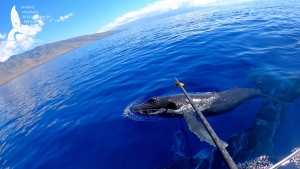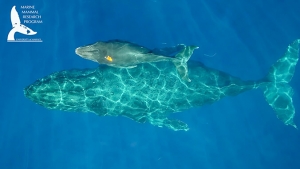Video by UH Mānoa Marine Mammal Research Program PhD candidate Martin van Aswegen. (NOAA permit #21476)
As humpback whales nursed their calves in waters off of Maui in February, University of Hawaiʻi at Mānoa Marine Mammal Research Program (MMRP) researchers were there to capture stunning and rare video and data. It was part of an exciting new project that aims to quantify the nursing behavior of humpback whale calves on the Maui breeding grounds.
The project is a collaboration between the UH Mānoa Marine Mammal Research Program, the Goldbogen Lab at Stanford University’s Hopkins Marine Station and the Friedlander Lab at University of California, Santa Cruz.
“We can actually see what these animals are seeing and encountering and experiencing themselves,” MMRP Director Lars Bejder said. “Itʻs quite unique and rare footage that we’re obtaining, which is allowing us to quantify these nursing and suckling bouts that are so important.”

Over 10 days, Bejder and PhD candidates Martin van Aswegen and Will Gough attached non-invasive suction-cup tags equipped with cameras, acoustic recorders, pressure sensors and accelerometers onto seven humpback whale calves. Bejder said the tag deployments would not have been possible without the generous support of Marc Lammers from the Hawaiian Islands Humpback Whale Sanctuary, Stephanie Stack and Jens Currie from the Pacific Whale Foundation and the Oceanwide Science Institute.
The camera recordings are providing researchers with seldom seen nursing behavior (including nursing frequency and durations) and social interactions between individuals. The accelerometer data is allowing them to quantify the fine-scale behavior, movement and breathing patterns of tagged whales.
The fieldwork also consisted of flying drones equipped with altimeters and cameras with undistorted lenses, over the tagged whales, allowing researchers to calculate their overall length, body condition and health.
In 2019, Bejder and his collaborators used similar technologies to document humpback whale bubble-net feeding behaviors in Southeast Alaska. He said, “Combining these data sets across the foraging and the breeding grounds is really going to tell us something about the importance of these different habitats for these animals.”

Humpback whale research in Hawaiʻi continues to be highly collaborative. Bejder said the tag deployments would not have been possible without the generous support of multiple organizations. Molokai Ocean Tours, PacWhale Eco-Adventures and Rachel and John Sprague were all instrumental in helping to retrieve the tags once they were off of the whales.
Keep up to date through the MMRP website and social media platforms (Twitter: @MMRP_UH and Instagram: @MMRP_UH, Facebook: MMRPUH, Youtube: MMRP UH) to build awareness. To help achieve its mission, the program is also accepting donations to fund research initiatives and student scholarships. All donations are tax-exempt.
All research activities were conducted in accordance with NOAA permit #21476 and Institutional Animal Care and Use Committee approval. All drone activities were conducted in accordance with FAA Part 107 regulations.
—By Kelli Trifonovitch

